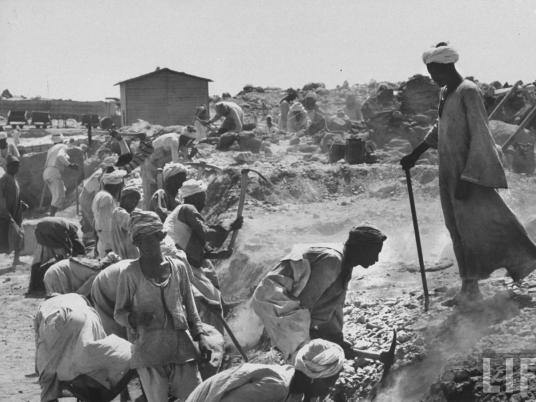
During late President Gamal Abdel Nasser’s reign, Egypt was generally seen as a site for booming industry, with factories erected all across the country and workers, according to the 23 July 1952 revolution’s new laws, becoming a major and empowered force in society.
The cultural production of the time reinforced these emerging notions.
For one, the Aswan High Dam, a national project erected to generate electricity in the country’s deep south, was regarded as one of the reasons to hail the 23 July regime.
Take for example Sonallah Ibrahim’s 1966 "Insan al-Sad al-Ali" (Man of the High Dam), which he co-authored with Kamal al-Qilish and Rauf Mossad. The book simply reads as propaganda for the Nasser regime, in which building the High Dam is shown as an epic undertaking by Egypt’s workers.
Colloquial poet Abdel Rahman al-Abnoudi also rode the wave by featuring the transformations of an Upper Egyptian worker at the High Dam project in “Letters of Heragy al-Qot.” In this series of colloquial poems, Heragy, an Upper Egyptian farmer, takes pride in recounting his experience as a casual laborer in the High Dam project. The poems show the immense transformation he goes through by being part of a colossal construction project, which he perceived, like many Egyptians, as a sign of the new, modern and independent Egypt.
This narrative on the High Dam represented the peak of a wider state-crafted notion that Egypt would not achieve its truly recognized independence unless it moved forward to be a modern industrial space. In this space, every Egyptian was portrayed as an active producer.
My late father, however, had a different story.
Long ago, he told me that Upper Egyptians in the Nasser era generally perceived the High Dam project, as well as the preceding huge sugar factories built all around Qena and Aswan, with suspicion.
Farmers in our hometown refused to leave their villages and limited agricultural land to go work in nearby towns in these sugar factories. They also refused to leave and work on the construction of the High Dam despite financial incentives to do so.
These new industrial complexes were erected on the very agricultural lands that farmers wished to appropriate and cultivate. The move to the High Dam construction site represented a threat to the perceived stability and attachment to one’s land alongside the aspiration to cultivate and groom one’s extended family.
Hence, many opted to sideline themselves from this state-sponsored hype, letting the Egyptians of the cities and the Delta come and rejoice in their new “worker” identities.
Nasser’s regime seemed aware of farmers' opposition to these industrialization schemes and thus tried hard to make factories more appealing to the public. One tactic was using popular songs to speak favorably of factories and workers; and indeed those years witnessed an unprecedented torrent of songs praising factory work.
What follows is a selection of songs, popular at the time, praising a strong nation built by its expanding labor force. While these songs were heavy in advocating for this industrial project, they didn’t touch on always contentious issues of labor rights.
One of the most famous labor songs inaugurating this trend — of using art to attract people to the merits of industrialization — is “Dour Ya Motor” (Run, O Engine), written by Beyram al-Tunsi and sung by Laila Mourad. In the song, Tunsi deployed a simple anti-colonial tone to attract people to his message: industrialization is a patriotic duty.
Mourad sang:
Run, O engine, play the greatest role / As you please, weave your wool / Free from monitors and control / Egypt’s now free, even if it goes naked / Never wear [clothes] from oversees / Neither pink silk, nor castor / Run, O engine
Come my brother, take from me / Products made craftily / Hell with London and Bristol / Run, O engine
Iconic filmmaker Youssef Shahin featured this song in his 1952 film “Sayedat al-Qetar” (Lady on the Train). What’s striking about the song’s clip is that Mourad walks through the factories among female workers. Inside the factory, the camera focused on scores of female workers in an attempt to portray women’s role in factories, although their contribution to the workforce was limited at the time and they suffered from unequal pay vis-a-vis their male counterparts.
Another song about workers is “Mahlaha al-Eid al-Shaghala” (How Great Are the Working Hands) sung by Sherifa Fadel. It goes:
How great are singing hands / Show us your spirits, farmers / Engines, for long, yearning / Sing the prettiest songs / Go, engines, we’re listening / To your meaningful songs / By our love to you we swear / Your favors in the heart we bear / From now on the factory is home / On the boys we pin our hopes / For high spirits will sing / And say the best words
Fadel's soothing voice and the song's intimate lyrics made this Egypt’s most famous song about workers.
Legendary singer Abdel Halim Hafez also sang for the factories. “Badlety al-Zar’a” (My Blue Overalls), however, didn’t achieve much success, probably because Hafez’s tender tone didn't match the perceived masculinity associated with factory work. The exaggerated tone of the lyrics might be another reason it did not become popular.
Hafez sang:
My blue overalls fit me / Their beautiful color tells / Who I am, what I do / My blue overalls I wove / Wearing them makes me handsome / Even on my birthday / They don’t leave me / They keep my prestige day and night / Look prettier when I work
Another popular song in workers’ circles was Abdel Aziz Mahmoud's "Million Salam" (A Million Salutes).
He sang:
Many salutes for men / Who with hope beat fear / With labor beat sleeping / With hands break rocks / From toil I see the foreheads sweat / The more engines turn / More fortune they return / The more the nation earns / My sweet country, your hug is a wonder / Here are the girls / Out early to reap grapes / And to your call, mother Egypt / We shall respond
However, many intellectuals following the 1967 defeat in the war with Israel, began a process of questioning the Nasser-era legacy of Egypt as a unified nation based on strong industry.
Ibrahim himself mocked “Insan al-Sad al-Ali” in his 1974 novel “Nigmit Oghostos” (The Star of August), in which he tried to take the sacredness out of the legacy of the High Dam.
Today, what perhaps remains of this legacy are the songs recalled on May Day of each year, not necessarily for their sheer artistic value, but to ponder over the changing significance of the labor movement across different political landscapes.




